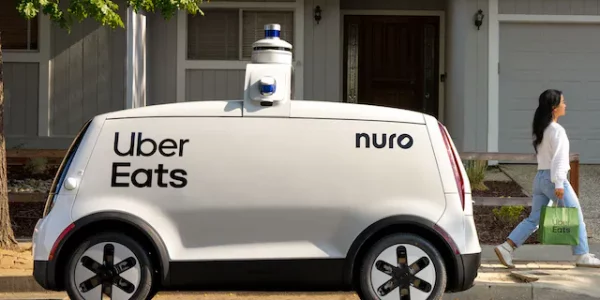Uber Eats has been facing financial difficulties for a while…like its entire existence. The food order app helped Uber handle the drop in ride sharing during the pandemic, but Uber Eats still loses billions. They bring in billions, it’s true, but there’s very little profit involved.
Uber Eats makes money by charging both customers and restaurants a fee. However, the fees add up to less than the cost of doing business. The biggest cost: the drivers. Drivers average jut $15 an hour, but that’s enough to keep Uber Eats from being profitable.
Robots to the rescue?
Uber Eats has a plan. They want to replace their drivers with robot delivery vehicles. That will cut their labor costs significantly and make them profitable (they hope).
Unlike so many companies, Uber Eats is completely forthright about their plans to replace their human workforce with robots. They have a ten-year contract with Nuro, a maker of driverless vehicles, to start automated deliveries in Houston and Mountain View and then to roll them out across the country. With people off the payroll, Uber Eats will be in a much better financial position.
There is no pretense that the drivers will have opportunities to try out new challenges. The whole point is to save money.
However, that’s not the whole story.
Regulations are a roadblock
Nuro has been a trailblazer for autonomous vehicles. They were the first company to get a permit for autonomous vehicles in California. The R2 vehicles they’ll be using for Uber Eats deliveries are smaller than a regular car — too small for passengers or a human driver — and they have a special exemption from the Department of Transportation for commercial autonomous use.
However, permission to use automated delivery bots depends on the state, county, and even city where the deliveries are being made. Nuro and Uber Eats will have to fight for permits in every single jurisdiction where they want to offer their service.
One R2 can carry a couple dozen grocery bags, or about 500 pounds of food. Dash Bridges points out that this isn’t all that drivers do. Keeping the bags upright, carrying them up stairs, and talking with customers are tasks that will be beyond the scope of the R2 for some time. Frozen food delivery company Schwann’s recently began asking customers whether they want contact with a driver or not. If enough customers are okay with having their food deliveries dropped off on the porch or stoop with a text announcing the delivery, the robots may be fine.
Regulations continue to be the limiting factor, but a ten year contract should give time to work that out.



